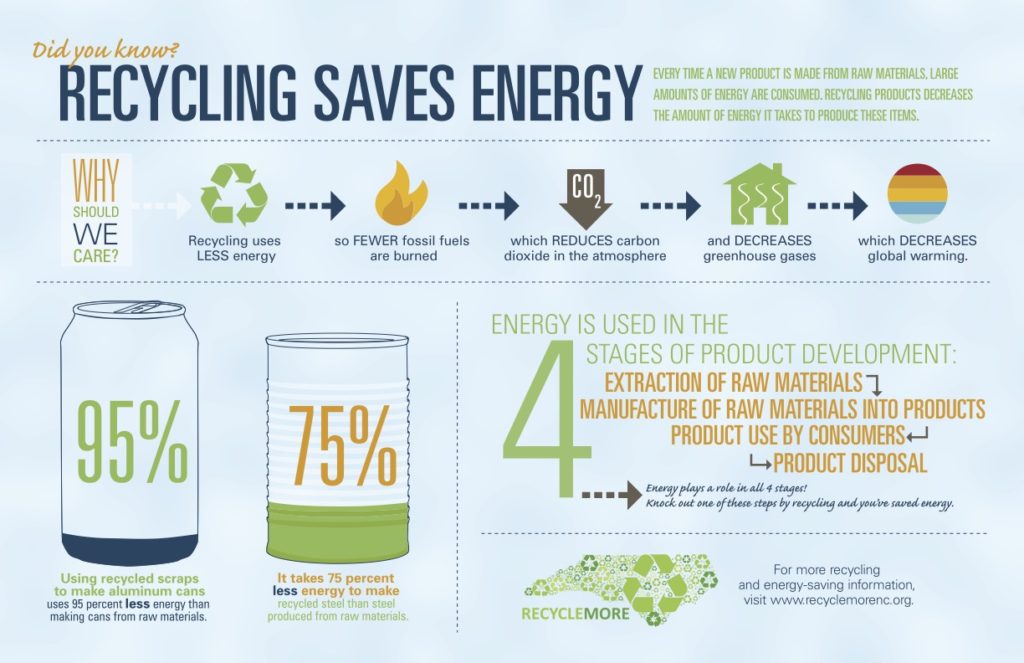ABC's of Recycling,
E – Stands for Energy
Apr 25 2022
Recycling doesn’t only save materials. It saves energy.
We all know that recycling helps keep things out of landfill and reduces our overall waste. But did you know recycling saves massive amounts of energy? It’s true! Turning recycled items into new usable material requires much less energy than mining and processing raw materials.
This means that recycling reduces waste, while ALSO reducing the harmful effect of burning fossil fuels. Burning fewer fossil fuels means adding less CO2 to the atmosphere, which is key to decreasing a major cause of global warming.

According to the non-profit, American GeoSciences Institute, recycling metals creates the biggest energy savings. Makes sense. Did you know that US aluminum production uses more electricity than any other manufactured product? But recycled aluminum only needs to be cleaned and re-melted. In comparison, recycled aluminum saves 95% of the energy that would be required to produce the same amount of aluminum from ore.
In other words, the amount of energy it takes to make one new-aluminum can, could create 20 recycled cans, and a lot faster. In practical application, recycling even one aluminum can save enough energy to keep a 100-watt bulb burning for almost four hours.
The EPA estimates the following energy savings for recycled materials:
- Steel – saves 60%-74% of the energy needed for raw materials
- Paper – saves about 40% of the energy needed for raw materials. By recycling just one ton of office paper you’ve saved 17 trees; 7,000 gallons of water; 463 gallons of oil; 3 cubic yards of landfill space, AND enough energy to heat an average home for six months!
- Plastic – saves about 33% of the energy needed for raw materials. That means recycling one ton of plastic saves over 16 barrels of oil.
- Glass – saves about 30% of the energy needed for raw materials
Wow. What else can be recycled for energy savings?
Glad you asked. Both textiles and electronics (phones, laptops, hard drives, basically anything with a chip in it,) also create energy savings by recycling.
Did you know that textiles account for 10% of global carbon emissions? In fact, the textile industry is the world’s second-biggest industrial polluter, behind oil. There are other environmental impacts as well. According to the Wall Street Journal (2/17/09), it takes 700 gallons of water to make one t-shirt. Just one! (Hint: lots of water is used in manufacturing fibers.) “Closing the loop” is the phrase recyclers use to describe getting an item back into consumers’ hands without manufacturing from raw materials. Closing the loop on textiles saves both energy and water. In our area, there are now textile recycling locations where you can bring your old, stained, torn bedding, toweling and clothes instead of throwing them away.
SCARCE provides educational presentations on textile reuse and recycling. Presentations can be held in our education center or at an off-site location such as a library, business or school. To learn more about local textile recycling, try these links:
- DuPage County Waste Recycling & Green Initiatives:Textile Recycling & Clothing Donation
- Kane County Recycles
- Cook County Green Guide
Recycling electronics saves energy and keeps dangerous materials out of landfill–where it can leach into our groundwater. According to Illinois’ Rock Island Waste Management Agency, recycling one million laptops saves the energy equivalent to the electricity used by 3,657 U.S. homes in a year. One metric ton of circuit boards can contain as much as 800 times the amount of gold and 40 times the amount of copper mined out of one metric ton of ore in the US.
You know what that means? “There’s gold in that there garbage, partner!”
According to Harvard University’s Sustainability page, “reusing the precious metals and plastics in old cell phones alone could save as much energy as flipping off the power to 24,000 US homes for an entire year.” The site goes on to say that in 2009, the EPA estimated there were 2.37 million tons worth of household electronics headed for disposal. “Enough to almost fill five football stadiums.” Think of the resources that could be saved if those items were recycled and not trashed!
Understanding the energy value of recycling makes it even more clear why it’s important to create a healthy system for handling waste that includes reclaiming the resources at hand through recycling. It’s cost-saving, it’s healthier and it’s smart!
